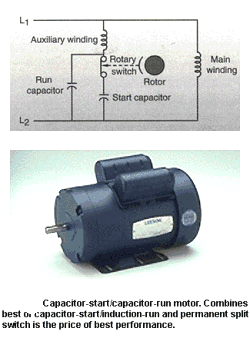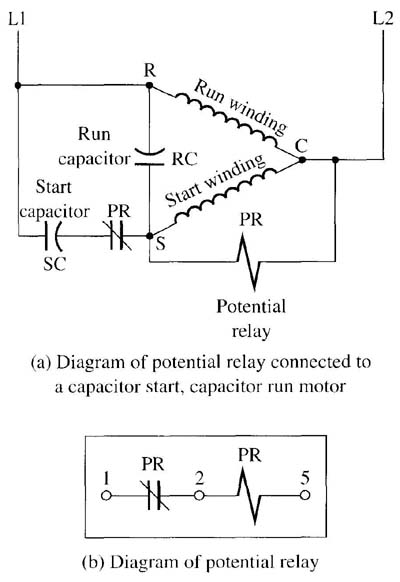 The capacitor start, capacitor run (CSCR) motor adds a run capacitor
to the start capacitor, which provides the motor with better torque characteristics
when the motor is operating at full speed.
The capacitor start, capacitor run (CSCR) motor adds a run capacitor
to the start capacitor, which provides the motor with better torque characteristics
when the motor is operating at full speed.
The run capacitor is usually oval or square shaped and has a metal housing rather than plastic. The metal housing allows the run capacitor to radiate any heat that is built up inside it, since it's connected to remain in the run winding circuit at all times.
From the diagram in Fig. 1a (below) note that the run capacitor is essentially connected to the capacitor start, induction run motor. This type of motor is used almost exclusively for hermetic compressor motors in air-conditioning systems. One will find air-conditioning systems connected to most modern electronic panels today to provide the additional cooling that is required when computers, motor drives, and other amplifiers are placed in an enclosed cabinet.

Above: Fig. 1: (a) Capacitor start, capacitor run motor connected to
a potential relay. The potential relay is used to energize and de-energize
the start winding. (b) Diagram of a potential relay. (a) Diagram of potential
relay connected to a capacitor start, capacitor run motor; (b) Diagram
of potential relay.
For this motor, the run capacitor is connected in parallel with the run winding. It will be in the circuit during starting and remain in the circuit while the motor is running. During the time the motor is starting, the additional capacitor provides a little more phase shift than the start capacitor alone, which gives the motor more starting torque.
After the motor is running, the start capacitor is disconnected from the start winding circuit when the potential relay contacts open, but the run capacitor remains in the circuit because it’s wired directly across the R and S terminals. If the load increases slightly because the compressor is trying to pump more refrigerant, the run capacitor will provide a small phase shift to give the rotor more torque and regain the loss of rpm quickly. The larger the load increase is, the more speed the rotor will lose, which will cause additional current to be drawn. The increase in current will pass through the run capacitor and cause it to provide a larger phase shift, which in turn provides the rotor with more torque. The run capacitor allows the speed of the motor to remain fairly constant when the load is constantly varying.